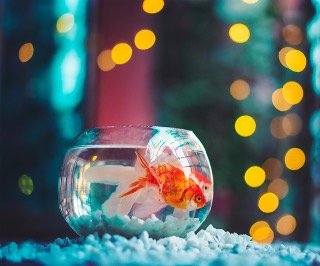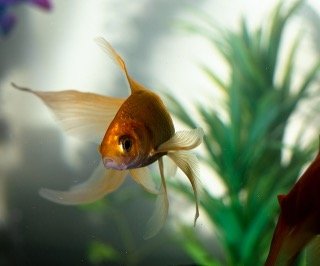
Red Cap Oranda Goldfish
Fish make lovely pets, and watching them run around in your tank can be quite comforting. They can also be quite interactive. While they will never play with you or curl up on your lap, Red Cap Orandas recognize their owners and often show little to them when they get attention. These lovely little goldfish grow to be about 10 inches long and live for 10 to 15 years or more with proper care.
The Redcap Oranda Goldfish is the preferred variety of the Oranda Goldfish. Orandas are very attractive and are some of the most popular goldfish in the world, and the Redcap variety is one of the most loved species.
This beautiful goldfish has a large, rounded body and shimmering scales as well as long, flowing split tail fins similar to all oranda varieties. When the fish stops swimming, the delicate tail sticks out, which looks like flower petals.
Unlike the common goldfish, with its long slender body, this fancy goldfish is one of the more round or egg-shaped fancy goldfish. The Redcap Oranda is completely white except for a cherry red hood on its head, which looks like a cap. All of its fins except the dorsal fin are paired, and the tail fin is usually divided.
Beyond their overall good looks, these fantasies are loved for their hoods. It is a fleshy growth on the top of the head known as a wen. The wen will begin to appear when the fish is about 3 – 4 months old, but it actually starts to form at about 1 – 2 years old and will be fully developed in 2 – 2 1/2 years.
The redcap oranda fancy goldfish can be confused with the lionhead goldfish when their coloration is very similar. Redcap Oranda Goldfish are very popular and widely available, but they are considered delicate and are not recommended as beginner fish.
Unlike flat-bodied types of goldfish, they have a low tolerance to pollution and cannot tolerate extremely cold temperatures. The hood is subject to infection from debris, bacteria and fungi that settle in the tiny folds.
Orandas are available in a variety of colors, often orange, red, red and white, red and black, black, blue, chocolate, bronze, white or silver, black and white (panda color), red-black and white (tricolor), and Calico color.
Special Care
Orandas can be housed with other goldfish and are sensitive to low water temperatures. If their wen enlarge too much, it can hinder vision so it is advisable to keep them with other goldfish with equally poor eyesight to ensure that they do not starve because of competition with a competent vision.
Some aquarists prefer to trim goldfish wen using scissors to prevent blindness and douse them with peroxide to prevent damage to essential areas around the face or body. Her wen is also suspected to have been hurt by rough objects kept in his residence.
Choosing a house
If desired, you can keep your red-cap goldfish in a clean, outdoor pond. The pond must be at least 2 feet deep and hold 250 gallons or more. If you live in the U.S. The Department of Agriculture plant hardiness zones 4 or colder, leave the pond or bring your fish indoors for the winter.
When choosing an indoor tank, choose a tank that holds at least 20 gallons of water. Start with a 20 gallon tank and add 10 gallons for each new oranda. Goldfish require a lot of oxygen, so each fish needs plenty of breathing room.
This need for oxygen also determines the best size for the fish tank. Ideally, you should provide the largest water surface area you can. Rectangular tanks with wide tops are therefore preferable over circular bowls or octagonal tanks.
Get ready for the day on the go
Once you have a tank, you need to prepare it for your new fish. Begin by lining the bottom of the tank with gravel, unless you plan to use an undergravel filter. In this case, the filter goes before the gravel.
You can use any filter you like as long as it provides mechanical, biological and chemical filtration, but undergravel filters blend better and improve the aesthetics of the tank.
Care and Feeding
Red caps are more concerned about water quality than common goldfish and require very clean water. In addition to running the filtration system, you’ll need to do water changes twice a week.
To do this, remove about 30 percent of the water from your fish tank. Replace it with bottled water or tap water that you have either conditioned to remove chemicals or allowed to sit for 24 hours.
Feed your oranda three times a day, remembering to mix a little into their diet. As omnivores, red hats enjoy both meat and vegetables.
Feed your fish a high quality flake food every day and then feed it brine shrimp, bloodworms, and the occasional lettuce leaf. When feeding worms and shrimp, always provide frozen samples so you don’t accidentally introduce bacteria or parasites into its environment.





